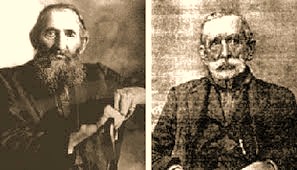THE FAMILY FEUD
In the early 19th
Century both families had settled in the Tug Valley along the Kentucky-West
Virginia border. The McCoys put down roots on the Kentucky side of a stream
called Tug Fork, while the Hatfields lived on the West Virginia side. By the
time of the Civil War each family was headed by an ambitious and
confrontational man. The McCoy family was led by Randolph McCoy. The patriarch of the Hatfield clan was William “Devil Anse” Hatfield.
Trouble started during the
Civil War; the Hatfields fighting for the Confederacy and the McCoys for the
Union. After being discharged from the Union Army, young Harmon McCoy,
returning home from the war, was hunted down and killed by resentful Hatfield
kin folk.
Purloined pigs, crooked
courts, and rising resentment fueled even more violence. Hostilities peaked in
1882 when three of Randolph McCoy’s sons killed Ellison Hatfield, the brother
of “Devil Anse” Hatfield, leader of the Hatfield family. “Devil Anse”
retaliated by capturing and executing the three McCoy brothers, without a trial
of course, by tying them to a tree and shooting them. The accompanying photo
shows heavily armed Hatfields.
Violence surged and receded
for the next few years. In 1887, a lawyer, the cousin of Randolph McCoy, used
his influence to have the murder indictments reissued against the Hatfield boys
who had killed the McCoy brothers. Their extradition from West Virginia to
trial in Kentucky was slow and frustrating, so the McCoys raided the Hatfield
settlement taking several men captive back to Kentucky for trial.
The Hatfields were enraged
and planned to kill Randolph McCoy. On January 1, 1888, a
party of Hatfield men surrounded McCoy’s home and opened fire on his family
sleeping inside. They set fire to the house killing two of Randolph’s children
and beating his wife, who they left for dead. This has been called the New
Year’s Night Massacre.
Now the conflict expanded.
It was not only between the two families, but between Kentucky and West
Virginia. The Governors of both states called up the National Guard as more
retaliation raids were made by the McCoys into West Virginia. The governor of
West Virginia accused Kentucky of violating the extradition process and took
the issue to the U.S. Supreme Court. The Court ruled against West Virginia (and
therefore damaging the Hatfield cause). All eight Hatfield men were found
guilty of murder by a Kentucky jury; seven were sentenced to life in prison and
one was executed for murdering the daughter of Randolph McCoy.
The bloodshed had finally
reached its finale, but the “Hatfields and McCoys” became an American metaphor
for any harsh rivalry.




No comments:
Post a Comment